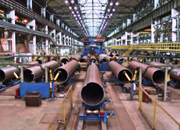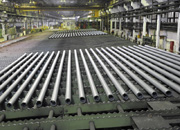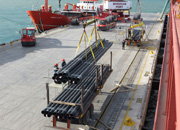High-strength Q460C seamless steel pipes, as an important engineering material, occupy a vital position in industries such as construction, machinery, energy, and transportation due to their excellent mechanical properties and wide range of applications. Q460C is a low-alloy high-strength structural steel. In its naming, "Q" represents the yield strength of the steel, "460" indicates a yield strength of 460 MPa, and "C" indicates the quality grade. This steel, through reasonable composition design and advanced production processes, achieves a perfect combination of high strength, high toughness, and good weldability, meeting the stringent requirements of modern engineering for material performance.
From a production process perspective, high-strength Q460C seamless steel pipes are mainly produced using hot rolling or cold drawing processes. The hot rolling process involves heating the steel billet to a high temperature, then piercing, rolling, and sizing it to ultimately form a seamless steel pipe. This process has high production efficiency and is suitable for mass production, but the surface quality and dimensional accuracy of the product are relatively low. Cold drawing further processes hot-rolled tubes at room temperature, using dies to draw the steel to achieve higher dimensional accuracy and surface finish, while also improving the material's strength and hardness. Both processes have their advantages and can be chosen based on the needs of different applications. It is worth noting that the production process of Q460C seamless steel tubes requires strict control of parameters such as chemical composition, rolling temperature, and cooling rate to ensure that the final product has stable mechanical properties and good microstructure uniformity.
In terms of chemical composition, Q460C seamless steel tubes typically contain basic elements such as carbon, silicon, manganese, phosphorus, and sulfur, as well as microalloying elements such as vanadium, niobium, and titanium. The proper ratio and interaction of these elements are key to ensuring the high strength and high toughness of the steel. Specifically, controlling the carbon content below 0.20% ensures sufficient strength while avoiding deterioration in weldability; the addition of microalloying elements significantly improves the steel's strength through grain refinement and precipitation strengthening mechanisms. Furthermore, strict control of phosphorus and sulfur content also ensures good low-temperature impact toughness.
From a mechanical property perspective, the most significant characteristic of Q460C seamless steel pipe is its high strength. Its yield strength can reach over 460 MPa, and its tensile strength is between 550-720 MPa, far exceeding that of ordinary carbon structural steel. Simultaneously, after appropriate heat treatment, this steel also exhibits good plasticity and toughness, with an elongation exceeding 17%, and its impact energy at -20℃ meets the requirements of most engineering applications. This balance between high strength and good toughness makes Q460C seamless steel pipe particularly suitable for applications bearing heavy loads and impact loads.
Weldability is one of the important indicators for evaluating structural steel. Q460C seamless steel pipe achieves good weldability by reducing the carbon equivalent (usually controlled below 0.45%) and employing appropriate microalloying technology. In actual welding, using appropriate preheating temperature and welding process parameters can yield welded joints with excellent performance. However, it should be noted that because Q460C is a high-strength steel, post-weld heat treatment is generally not recommended to avoid affecting the properties of the base material.
In terms of applications, high-strength Q460C seamless steel pipes are widely used in many important industries due to their excellent comprehensive performance. In the construction industry, they are often used in the main structures of super high-rise buildings and the truss structures of large stadiums, reducing structural weight and improving overall safety. In the engineering machinery industry, Q460C steel pipes are used to manufacture key components such as crane booms and excavator booms, bearing enormous working loads. In the energy sector, this material is used in oil drilling equipment and wind power towers, maintaining stable performance even in harsh environments. Furthermore, Q460C seamless steel pipes play an irreplaceable role in bridge construction, shipbuilding, and pressure vessels.
From a market supply perspective, many large steel companies in my country have the production capacity for Q460C seamless steel pipes. For example, Q460C seamless steel pipes produced by a steel company in Chongqing are widely used in key engineering projects in Southwest China. These manufacturers typically possess advanced production equipment and strict quality control systems, enabling them to provide products of different specifications and performance grades according to customer needs. The outer diameter of commonly available Q460C seamless steel pipes ranges from tens to hundreds of millimeters, and wall thicknesses are also available in various options to meet the specific needs of different engineering projects.
Regarding use and maintenance, while Q460C seamless steel pipes possess excellent weather resistance, appropriate protective measures are still required in special environments. In corrosive environments, it is recommended to galvanize, paint, or perform other anti-corrosion treatments on the pipe surface. When used in low-temperature environments, special attention should be paid to whether the material's low-temperature impact toughness meets the requirements. Furthermore, during processing and installation, mechanical damage to the material should be avoided, especially by preventing sharp notches on the pipe surface to prevent stress concentration.
With the continuous development of infrastructure construction and the transformation and upgrading of the manufacturing industry in my country, the market demand for high-strength Q460C seamless steel pipes is showing a steady growth trend. Especially in key national strategic areas such as "new infrastructure" and clean energy, the demand for this high-performance material is even more urgent. In the future, the production technology of Q460C seamless steel pipes will develop towards greater efficiency and environmental friendliness, and the performance of the products will be further improved to meet increasingly stringent engineering application requirements.
From a standards and specifications perspective, the production and application of Q460C seamless steel pipes need to comply with multiple national and industry standards. GB/T 1591-2018 "Low-alloy High-strength Structural Steel" sets forth clear requirements for the chemical composition and mechanical properties of Q460C steel; GB/T 8162-2018 "Seamless Steel Tubes for Structural Use" specifies the technical requirements for seamless steel pipes used in structural applications. In practical engineering applications, designers and construction personnel need to strictly adhere to relevant standards and specifications to ensure that the selection and use of materials meet engineering requirements.
It is worth noting that Q460C seamless steel pipes also face some technical challenges during use. For example, their performance in extremely low-temperature environments, fatigue performance after long-term service, and joining techniques with dissimilar materials all require further research and solutions. To this end, steel companies and research institutions are continuously optimizing material composition design and production processes to develop upgraded products with superior performance.
In summary, high-strength Q460C seamless steel pipes, with their excellent mechanical properties, good processing performance, and wide application adaptability, have become an indispensable key material in modern engineering construction. With the continuous advancement of materials science and the ongoing innovation of manufacturing processes, Q460C seamless steel pipes will undoubtedly play a vital role in more fields, making greater contributions to social development and technological progress. For engineering technicians, a thorough understanding of the characteristics and key applications of this material will help to better leverage its performance advantages and create safer and more economical engineering structures.
 Threeway Steel is known as a professional supplier engaged in manufacturing and distributing a wide range of steel pipe, and our headquarter located the central part of China – Hunan and six associated factories throughout China.
Threeway Steel is known as a professional supplier engaged in manufacturing and distributing a wide range of steel pipe, and our headquarter located the central part of China – Hunan and six associated factories throughout China.
 Threeway Steel is known as a professional supplier engaged in designing, manufacturing and distribution of a wide range of steel products with the headquarter located the central part of China – Hunan and six associated factories throughout China.
Threeway Steel is known as a professional supplier engaged in designing, manufacturing and distribution of a wide range of steel products with the headquarter located the central part of China – Hunan and six associated factories throughout China.
 Threeway Steel is known as a professional supplier engaged in designing, manufacturing and distribution of a wide range of steel products with the headquarter located the central part of China – Hunan and six associated factories throughout China.
Threeway Steel is known as a professional supplier engaged in designing, manufacturing and distribution of a wide range of steel products with the headquarter located the central part of China – Hunan and six associated factories throughout China.
 Threeway Steel is known as a professional supplier engaged in designing, manufacturing and distribution of a wide range of steel products with the headquarter located the central part of China – Hunan and six associated factories throughout China.
Threeway Steel is known as a professional supplier engaged in designing, manufacturing and distribution of a wide range of steel products with the headquarter located the central part of China – Hunan and six associated factories throughout China.
 Threeway Steel is known as a professional supplier engaged in designing, manufacturing and distribution of a wide range of steel products with the headquarter located the central part of China – Hunan and six associated factories throughout China.
Threeway Steel is known as a professional supplier engaged in designing, manufacturing and distribution of a wide range of steel products with the headquarter located the central part of China – Hunan and six associated factories throughout China.

